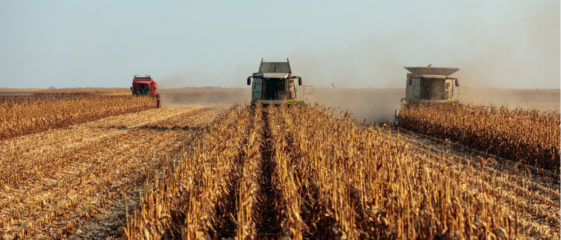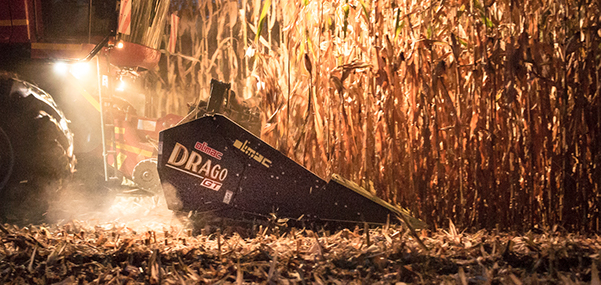15. August 2020
Harvest study
Harvest study highlights benefit of automatic deck plates for capturing yield:
- Field study shows significant in-row and row-to-row stalk thickness variability.
- Each Olimac Drago GT row unit adjusted itself automatically more than 160 times per minute to current stalk conditions.
- Hydraulic deck plates instead are adjusted correctly in only 26% of the time.
Corn growers understand the critical role of deck plates for capturing yield during harvest. University studies have shown that plate gaps as little as 3 mm wider than stalks could translate to a potential yield loss of 250 kg per hectare.* And while producers using operator-controlled hydraulic deck plates generally express confidence in their ability to manage gaps, a harvest comparison with automatic, selfadjusting deck plates suggests potential yield loss may be more significant than they believe. “The introduction of operator-controlled hydraulic deck plates certainly was an improvement compared to the fixed ‘one-size-fits-all’ deck plates they replaced,” says Dustin Bollig, farmer and North American marketing director for Dragotec USA. “But we’ve learned most growers over-estimate the yield-saving performance of hydraulic deck plates in harvest conditions.”
EYE-OPENING STALK VARIABILITY
Olimac has long described the advantage of their DRAGO corn heads‘ automatic, self-adjusting deck plates for minimizing gaps and limiting yield loss during harvest. To substantiate its claim, Dragotec USA conducted a field study to measure the gap “decisions” of Olimac DRAGO‘s automatic deck plates. The study revealed some eye-opening facts about the variability of corn stalks and the potential yield loss associated with it. “We wanted to quantify the overall ability of Olimac DRAGO‘s automatic deck plates to minimize gaps and related yield loss in harvest conditions,” Bollig says.

To help conduct the study, Dragotec USA worked with HeadSight®**, an independent manufacturer of header height control systems, for measurement and analysis of deck plate movement. “We provided electronic sensors, reading in millivolts, that have the capability of measuring movement to the 100th of a millimeter,” says Rob Schlipf, Director of Engineering at HeadSight. The sensors were attached to the right and left deck plates of a 12-row Olimac DRAGO GT corn head.
THE SENSORS REVEALED SIGNIFICANT VARIABILITY IN STALK SIZE WITHIN THE ROW.
“As the DRAGO GT corn head worked its way through the field, we not only could track the number of times deck plates moved, but how far apart they moved,” Schlipf says. The results confirmed what Olimac suspected and more.
NEARLY 163 DECISIONS PER ROW PER MINUTE
“The sensors revealed a significant variability in stalk diameters — plant-to-plant as well as row-to-row,” Bollig says. “Harvesting at 6,5 km/h, the automatic deck plates averaged 163 decisions per row per minute — adjusting from as little as 3 mm to as much as 13 mm.” “We were all aware of the variability in the field, and pleased to see how responsive the deck plates were adjusting to it,” Bollig says.
On a per-hectare basis, the automatic deck plates made nearly 13.222 decisions involving adjustments from 3 mm or wider, including 3.884 decisions of 6 mm or more, and 480 decisions of 12 mm or greater. “Keep in mind that the threshold for deck plate yield loss starts at 3 mm, and each row unit averaged 1.100 independent decisions per hectare involving that and more,” Bollig says. “The data also showed how both the left and the right deck plate of each row unit on the DRAGO GT worked in unison to minimize gaps.”

“Hydraulic-controlled deck plates are unable to compensate for row-to-row stalk variability, let alone the plant-to-plant variability within each row,” Bollig says. “Having the same gap setting for every row unit on a corn head assumes all of the stalks running through them are the same, too, and we know Mother Nature just doesn’t work that way.”
One of the more remarkable stats from the study is “deck plate spacing as a percentage of time,” Bollig says. “It illustrates the percentage of stalk thickness in the field we harvested. If your plates were set only for the most common stalk thickness, you would have been off nearly 75% of the time.” “Operators can’t possibly react to variability that’s out there. As it is, they are unable to see where their deck plates are set relative to stalks,” continues Bollig.

OPERATOR-CONTROLLED DECK PLATES MEASURED
Bollig’s statement was underscored when the HeadSight sensors were attached to the deck plates of a corn head with operator-controlled hydraulic deck plates. The farmer-operator was not informed what the sensors were measuring — rows harvested were next to those used to measure the Olimac DRAGO corn head with automatic deck plates.
“When we looked at the data, we realized the farmer operator had made only one deck plate adjustment within the designated harvest area,” Bollig said. “This was adjacent to the same area where the automatic deck plates had literally made thousands of independent gap decisions,” he points out.
“Of course, we don’t know how other producers would have reacted in that field, but what we saw is likely more typical than not. From the cab of a combine, any visual change in stalk diameter has to be significant. Most of the time, farmers just open their plates until they don’t push stalks and forget about it,” says Bollig. “Their confidence in managing deck plate gaps from the cab is based on the belief that ‘a good stand’ means minimal stalk variability in their fields, and we know that just isn’t true.”
“The ability to manually adjust deck plates has led to a false sense of their performance for capturing yield. The study confirmed the value of automatic, self adjusting deck plates for minimizing gaps and capturing yield every minute and in every row the corn head is working,” Bollig says. “When you multiply the potential yield savings by the number of corn hectares you grow, the difference can be significant.”
“Today’s farmers have too many distractions in the combine with too much variability in the field to adequately manage their deck plates,” notes Bollig. “And it’s costing them yield. When corn was seven dollars, we wanted every kernel and now when corn is at four dollars we need every kernel.”
FIELD STUDY DETAILS
- Date of data collection: 25th of October 2018
- Location of data collection: Midwes (USA) – Same field
- Corn heads used for trial:
- Olimac DRAGO GT 12-row head with self-adjusting deck plates mounted on a John Deere S680 combine
- John Deere 612 C Stalkmaster 12-row head with hydraulic deck plates mounted on a John Deere S680 combine
- Approximate harvesting speed of combines: 6,5 km/h
- Plant population: 86.500 per ha
- Growing season history: Harvested field had above normal moisture through most of the growing season negatively impacting plant development and yield
- DRAGO GT deck plate minimum gap setting was reduced to manage poor yield and smaller stalks

